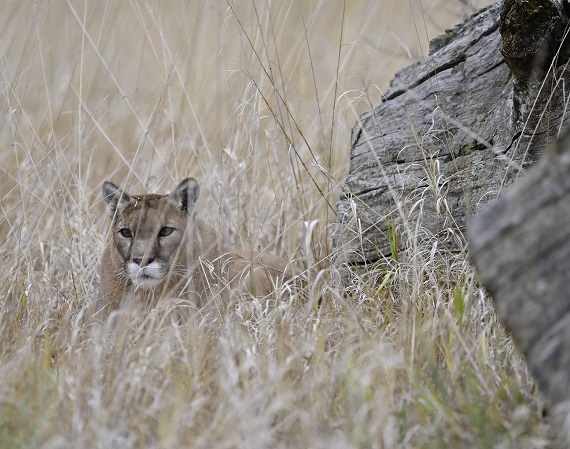By Elise Schmelzer
The Denver Post mountain lions online news
(The Denver Post) For decades, licensed hunters have killed hundreds of Colorado mountain lions every year to control the state’s population of the elusive feline.
Voters in November will decide whether to ban the practice, along with the trapping of bobcats. That prospect has set off a deluge of competing claims about what will happen if big-cat hunting ceases.
People supporting the ban say that mountain lion populations are self-regulating and will stabilize at a level supported by their available habitat and food resources. Those opposed to Initiative 91, meanwhile, say a hunting ban would induce a rapid increase in the number of big cats, which in turn would pose a significant threat to deer and elk herds.
The truth is likely a mix of the two, according to studies and experts.
But beyond biology, the statewide ballot measure is asking Coloradans to consider deeper questions about the future of Colorado’s wildlife, both opponents and supporters said.
State wildlife managers now set hunting limits on the number of mountain lions that can be killed while still maintaining a lion population, said Samantha Miller, the manager of the Cats Aren’t Trophies campaign. The ballot initiative’s proponents want wildlife managers to focus instead on how to foster the best and healthiest population possible for the intrinsic value of having the animal roam the landscape.
mountain lions online news
“I think it’s a fundamentally different question that we’re asking,” Miller said.
Mountain lion hunters represent about 1% of the more than 200,000 big-game hunting licenses the state sells every year. But hunters opposed to the measure fear it’s the first step in a slippery slope toward banning all hunting.
“You start taking out pieces of the puzzle and soon you don’t have a puzzle,” said Dan Gates, executive director and co-founder of the Colorado Trappers and Predator Hunters Association. He’s a leader in a number of groups opposing the ban, including Colorado Wildlife Deserves Better, Colorado Wildlife Conservation Project and Coloradans for Responsible Wildlife Management.
Self-regulation or out-of-control growth?
The number of mountain lions in Colorado is difficult to determine because of their elusive and solitary nature. Colorado Parks and Wildlife biologists estimate between 3,800 and 4,400 adult lions live in the state and say the population has grown since the species was classified as a big game species in 1965.
State biologists do not have an estimate for how many bobcats live in Colorado, but they believe the population is healthy and may be increasing in some areas.
Neither mountain lions nor bobcats are listed as federally threatened or endangered species. An estimated 20,000 to 40,000 mountain lions live in the U.S., as do more than 1.4 million bobcats.
“Both informal and recently collected empirical data suggest Colorado’s lion population is strong and lions are abundant in appropriate habitat,” states a Colorado Parks and Wildlife pamphlet on the species.
In the 2022-2023 hunting season — the most recent for which CPW data is publicly available — 2,599 people bought mountain lion hunting licenses and hunters killed 502 lions, making for a 19% success rate.
mountain lions online news
Those with opposing views of the ballot initiative posit different futures should mountain lion hunting be banned. But the truth is likely a mix of the two, said Jerry Apker, a retired CPW wildlife biologist who worked as the statewide carnivore biologist for 17 years before his 2017 retirement.
Populations would likely spike in the first years after hunting ends before increased mortality rates temper that growth, Apker said. Eventually, mountain lion populations tend to reach a stasis and fluctuate based on what food and habitat is available.
The felines have larger litters with higher survival rates when more resources are available, but in times of stress, they have smaller litters and more mortalities.
A cessation in hunting would also likely increase human interactions and conflicts with lions, he said. The most hunted lions are typically subadults and young adults — the same lions still working to establish home ranges. More young lions on the landscape means they will eventually be pushed to subprime habitats as well as more populated areas.
(Please click onto the image of the cat to hear Classical Music)

There’s no way of knowing how many mountain lions would live in Colorado should hunting stop — there’s never been a statewide research study done on the question, Apker said.
“I think the statements of doom and gloom that they’re going to take over are a convenient argument, but that’s not true,” he said.
Apker opposes the effort to ban mountain lion hunting, but he said other opponents’ argument that the ban would decimate elk and deer herds is far-fetched. While predation might increase, the largest impacts to deer and elk populations would come from human alteration of the landscape. Less habitat, the degradation of existing habitat and brutal winters are significantly larger factors that determine population change.
California comparison
mountain lions online news
Colorado and other western states have enacted various levels of restrictions on mountain lion hunting.
The Colorado Parks and Wildlife Commission earlier this year ended the state’s spring mountain lion season, instead restricting legal hunting to a single season that runs from November through March. The commission also banned hunters from using electronic recordings of other lions or distressed prey to lure mountain lions to an area.
The Washington Fish and Wildlife Commission in July voted in favor of stricter limits and shorter seasons for cougar hunting. It acted on a petition filed by a number of local and national conservation and animal rights groups.
California voters in 1990 chose to ban mountain lion hunting in the state permanently, though hunting of the felines had not been permitted since 1972 — when then-Gov. Ronald Reagan signed a moratorium. California is the only state with a full ban on hunting pumas, and it officially states that its aim is to instead conserve the species “for their ecological and intrinsic values,” according to the California Department of Fish and Wildlife.
A study published in 2020 compared California’s lion population with those in 10 western states where hunting is legal, including Colorado. The authors found that California had similar cougar population densities and similar average deer densities as the other states.
California also had the third-lowest rate of cougar-human conflicts per capita, similar rates of cattle depredation and lower rates of sheep depredations.
“In sum, our analysis of the records obtained from state and federal wildlife agencies found no evidence that sport hunting of pumas has produced the management outcomes sought by wildlife managers aside from providing a sport hunting opportunity,” the authors wrote.
Charges of “ballot-box biology”
Proponents of the hunting ban say it is a way to address unethical hunting methods, like the use of dogs, and whether hunting is necessary to manage lion populations. Opponents say it is another example of “ballot-box biology” that lets the majority make decisions often left to wildlife managers.
mountain lions online news
Apker disagrees the initiative is “ballot-box biology” — he doesn’t think it’s about biology at all. Instead, the question is a broader referendum on hunting as a whole, he said.
“The bottom line is that there are people who think hunting is wrong,” said Apker, who has voiced his opposition to the ballot measure publicly.
Proponents of the ban say hunting for mountain lions is trophy hunting because hunters are allegedly seeking the thrill of the hunt as well as the skins and heads of lions — not the meat. The ballot measure, if passed, would ban trophy hunting, defined as hunting “practiced primarily for the display of an animal’s head, fur, or other body parts, rather than for utilization of the meat.”
Cougar hunters have said repeatedly that while they do often pose with their kill — just like elk and deer hunters — they also eat the meat and are not hunting solely for a trophy. Colorado law requires that mountain lion meat be prepared for consumption by hunters. Gates, from the hunters association, has made steaks, tacos and burritos from lion meat.
“Not only do people eat mountain lion, but they also cherish mountain lion,” he said.
But ballot initiative supporters express doubt — Miller, for one, says there’s no way to know whether meat is eaten. The campaign is not against hunting, she said, but opposes unethical hunting.
“There are plenty of other species to hunt that aren’t so problematic under hunting ethics,” said Erik Molvar, executive director of Western Watersheds Project and a lifelong hunter, during a news conference last month in support of the ban.
©2024 MediaNews Group, Inc. Visit at denverpost.com. Distributed by Tribune Content Agency, LLC.
mountain lions online news


